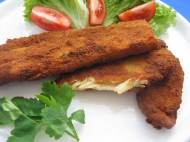Creating meat substitute cutlets from vegetables
 In an episode of popular sci-fi series Eureka, meat for the residents was cloned and grown as desired parts of a chicken. Led by a researcher from the Fraunhofer Institute for Process Engineering and Packaging (IVV) in Freising, a group of researchers involved in the EU-project LikeMeat came up with a different approach to solve the raising number of problems in meat production.
In an episode of popular sci-fi series Eureka, meat for the residents was cloned and grown as desired parts of a chicken. Led by a researcher from the Fraunhofer Institute for Process Engineering and Packaging (IVV) in Freising, a group of researchers involved in the EU-project LikeMeat came up with a different approach to solve the raising number of problems in meat production.
Researchers involved in LikeMeat project studied the properties of meat in order to create a meat substitute that tastes and looks like meat. According to them, the end product looks like a cutlet, it‘s juicy and fibrous as a cutlet, and it even chews with the consistency of a real cutlet – but the ingredients are 100 percent vegetable.
“Studies have shown that many Europeans are ready to give up meat, but there have only been a handful of alternatives until now”, explains Florian Wild, leading researcher from Fraunhofer IVV. “Our goal is to develop a vegetable surrogate for meat that is both juicy and fibrous, but that also has a pleasant flavor. The product should have a long shelf life, it should not be more expensive than meat, and be suitable for vegetarians and allergy sufferers.”
Wild and his colleagues came up with a new process for meat substitute creation. The main ingredients – water and plant proteins – are brought to a boil and slowly cooled down. As the temperature sinks, the protein molecules start to form chains. This gives rise to a fibrous structure that is quite similar to that of meat. The researchers experimented with different vegetables such as wheat, peas, lupins and soya, in order to avoid the potential problems of food intolerance and allergic reaction to the one or other substance this meat substitute could be made from.
The prototype of the new vegetarian cutlet factory is no larger than two table tennis tables and it is currently located in the Fraunhofer IVV laboratory. It can produce one endless piece of meat substitute that is approximately 1 cm (nearly half an inch) thick, and the current version of the machine can produce 60 to 70 kg (132 to 154 lbs) of the meat substitute per hour or 300 to 500 kg (660 to 1,100 lbs) per day. The end product can be shaped as desired, for example into little morsels for diced or thinly-sliced meats, or entire cutlets.
According to researchers, although the consistency and texture of the meat substitute are spot on, there is still a little work to do on the flavor. By the end of the project term, in one year, the meat substitute from the land should be every bit as good as a genuine cutlet, and it should be ready-to-eat directly from the machine.
In addition to the scientists at Fraunhofer IVV, experts from the University of Natural Resources and Life Sciences, Vienna (BOKU) are also participating in the development, as are consumer researchers from the University of Wageningen, in the Netherlands, and eleven small to medium-sized corporations that manufacture or do business in food or food ingredients. The team roster also includes two Austrian and one Dutch company that have hitherto only processed meat, as well as an organic food producer from Spain. They plan to present their new product at the Anuga FoodTec trade fair from March 27 through March 30 in Cologne.
Aside the concern of ethics in meat production, the process itself is complicated, costly and not eco-friendly. In order to generate meat, animals have to consume five to eight more times of grain. Combined with development and utilization of hydroponics, the solution toward more sustainable and environmental friendly future lays on improvements in meat substitute production technology and similar breakthroughs in food production.









Using canned or cooked beans, flavor with chicken or beef boullion and spices of choice. Use to make meatless tacos or pita sandwiches…even a spread for crackers.
From the house of economy to yours. Have a blessed day.